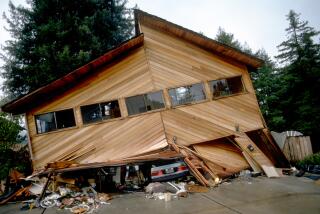Taking Crack at Common Problem
- Share via
Question: Our house is 35 years old with plaster interior walls. I’ve noticed hairline cracks in various parts of the walls and I’m wondering how safe they are. Should these be repaired? Are these cracks an indication of something structurally wrong?
E.E.
La Palma
Answer: “If there are quite a few you could have it checked out, but cracks are fairly common in a house that old,” says Pete Gorman of Rancho Lumber and Building Supply in Westminster. “Over time your house settles and the plaster walls don’t give, so they crack. You can patch them with a silicone caulk, which is more flexible, but you’ll always be able to see the caulk lines. Patching them with a plaster spackle will hide them, but the odds are the cracks will reappear. The only way to completely eliminate them is to cover the walls in a thin, quarter-inch drywall, which is a major job.”
Q: I have an entertainment center in the corner of my den with a TV, stereo equipment and VCR. Because of the way it’s built, I have to keep all the equipment against the wall and the cords and cables bend against it. Does bending these damage them over time?
T.E.
Laguna Hills
A: “The problem with crimping those cords is you create a weak point,” says Pam Ieoine of Martenet Hardware in Anaheim. “You’re affecting the insulation on the cord and creating a possible fire hazard. I would try to modify the area to allow the cords and cables to drop down freely.”
Q: We recently bought a pine chest that we’d like to strip and refinish to give it a whitewashed French country look. Once we get it down to the bare wood, what do we use for the whitewash?
S.V.
Placentia
A: “There are several whitewash stain kits available and they can be modified to match nearly any color stain,” says Harold Brobst of Hal’s Paint and Decorating in Fullerton. “You can change the color yourself by reducing or thinning the enamel down to a primer until you get the consistency of the white you want. You then coat the piece, then seal it with a urethane finish coat.”
Q: We recently bought an 8-year-old home that has two windowless bathrooms. The electric fan vents on the ceilings are extremely loud, and our neighbors have complained that their fans are also loud and they haven’t been able to find quieter replacements. Are quieter fans available?
A.P.
Lake Forest
A: “There are quieter fans you can get, but you may have to make some modifications to the vent opening you have,” says Manny Gwartz of B.J. Discount Plumbing and Heating in Garden Grove. “You probably have a tract home, since contractors usually put cheaper, noisier fans in them that just meet the code requirements. To install a quieter fan, you may have to cut a larger opening in the ceiling or make other changes in the vent, but if the noise bothers you enough, it can be done.”
Q: About once a month, our 5-year-old freezer in the garage leaks a puddle of water on the concrete. Other than this puddle, it works fine. Any suggestions?
R.T.
Fountain Valley
A: “It may be a problem in the freezer’s insulation,” says appliance repairman Dave Kilmer of Huntington Beach. “Over time the door insulation deteriorates and doesn’t seal like it should. Close the door on a piece of paper and then pull it out. If the paper pulls out freely, there’s too much of a gap. If it holds tight, the insulation is probably OK. After that I’d have someone come out and check to see if there’s a problem with water condensing on the inside of the freezer.”


